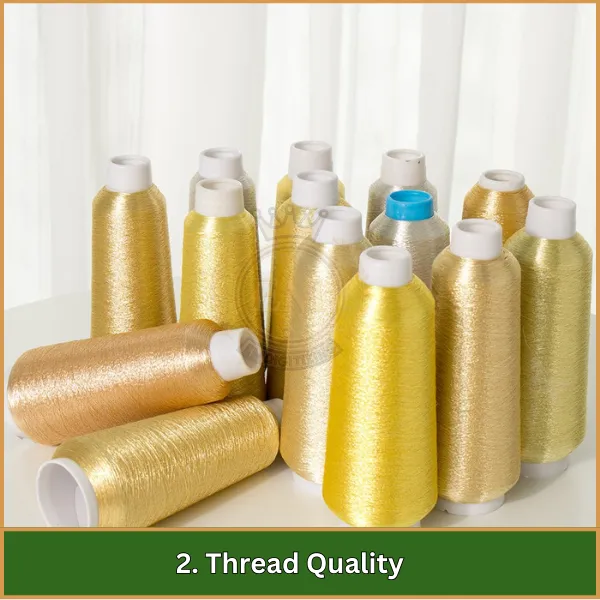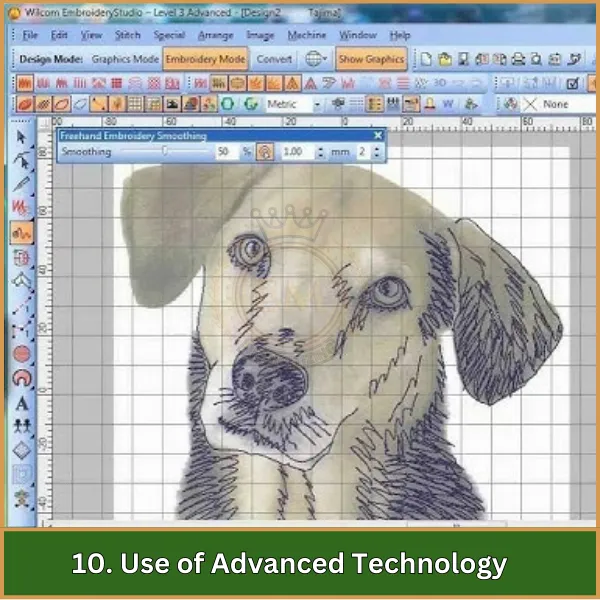Réaliser une broderie impeccable peut sembler délicat, mais quelques ajustements simples peuvent faire toute la différence. En se concentrant sur des facteurs spécifiques, vous pouvez améliorer la qualité de la broderie et produire des résultats de niveau professionnel.
Dans cet article, nous explorerons les facteurs clés qui contribuent à une meilleure broderie, du bon choix des matériaux à la maîtrise des réglages de votre machine, garantir que vos projets se déroulent magnifiquement à chaque fois.

12 Facteurs importants qui améliorent la qualité de la broderie
Facteurs pour améliorer la qualité de la broderie
Améliorer la qualité de broderie à la machine implique une attention particulière à plusieurs facteurs clés qui peuvent grandement influencer le résultat final.
- Acuité de l'aiguille
- Qualité du fil
- Tension du fil supérieur
- Tension de fil inférieure
- Épaisseur du papier de support
- Qualité des machines
- Tension de cadrage
- Respect des consignes
- Qualité du tissu
- Utilisation de technologies avancées
- Taille appropriée du cerceau
- Technique de retrait du stabilisateur
À présent, let’;Voyons comment chacun de ces facteurs contribue à améliorer la qualité de votre broderie..
1. Acuité de l'aiguille
Une aiguille bien aiguisée est cruciale pour une couture propre et précise, et c'est l'un des facteurs clés pour améliorer la qualité de la broderie machine.. Des aiguilles émoussées peuvent provoquer des effilochages et des points irréguliers, conduisant à une mauvaise finition. Changer régulièrement les aiguilles en fonction du type de tissu utilisé garantit des performances optimales.
Il est également important d'utiliser la bonne taille d'aiguille pour la combinaison de fil et de tissu.. Par exemple, une aiguille plus grosse est nécessaire pour les fils et les tissus plus épais, tandis qu'une aiguille plus petite convient aux matériaux plus fins.
2. Qualité du fil

Des fils de haute qualité sont essentiels pour la durabilité et l'apparence. Ils devraient être forts, grand teint, et adapté au tissu spécifique. Les fils de mauvaise qualité peuvent se casser facilement et ne pas conserver leur couleur au fil du temps., affectant l'aspect général de la broderie.
L'utilisation du type de fil approprié pour le tissu est cruciale pour améliorer la qualité de la broderie.. Par exemple, les fils en polyester conviennent à la plupart des tissus, tandis que les fils de rayonne offrent une finition brillante et sont souvent utilisés pour les matériaux délicats.
3. Tension du fil supérieur

Une bonne tension du fil supérieur est essentielle pour une couture équilibrée. Si la tension est trop forte, le fil peut se casser; if it’;c'est trop lâche, les points peuvent paraître bâclés. Le réglage de la tension en fonction du type de tissu et de fil permet d'obtenir une finition lisse.
La tension doit être suffisamment serrée pour éviter les boucles sur le dessous du tissu tout en permettant au fil de se déplacer librement dans l'aiguille..
4. Tension de fil inférieure

Similaire à la tension supérieure, la tension du fil inférieur doit être correctement réglée pour garantir une couture uniforme. Un déséquilibre peut entraîner des problèmes tels que des regroupements de fils ou des points lâches sur l'envers du tissu..
Le réglage fin des deux tensions est essentiel pour améliorer la qualité de la broderie.. La tension du fil inférieur doit être légèrement plus forte que la tension du fil supérieur pour maintenir une formation de point cohérente..
5. Épaisseur du papier de support
Le matériau de support fournit un soutien au tissu pendant la broderie. Choisir la bonne épaisseur évite la déformation et garantit que les points conservent leur forme. Un support trop fin peut entraîner des plis, tandis qu'un support trop épais peut être visible à travers le tissu.
Le type de matériau de support doit également être pris en compte, car certains sont plus adaptés à des tissus spécifiques. Par exemple, le support découpé est idéal pour les tissus tricotés, tandis que le support déchirable fonctionne bien pour les matériaux tissés..
6. Qualité des machines
La qualité de la machine à broder joue un rôle important dans le produit final. Les machines haut de gamme offrent une meilleure précision, plus de fonctionnalités, et une qualité de point améliorée.
Investir dans une machine fiable peut améliorer l’expérience globale de la broderie. Maintenance régulière, comme nettoyer et huiler la machine, aide à garantir des performances optimales et prolonge sa durée de vie.
7. Tension de cadrage
Encadrer correctement le tissu garantit qu'il reste tendu pendant le processus de broderie. Un tissu lâche peut entraîner des coutures inégales et des distorsions. Utiliser le bon cerceau et s’assurer que le tissu est bien maintenu peut éviter ces problèmes.
Le tissu doit être suffisamment tendu pour éviter tout affaissement, mais pas au point de déformer le motif ou d'endommager le matériau..
8. Respect des consignes
Following the manufacturer’;Les instructions relatives à la machine et aux matériaux sont cruciales. Cela inclut les réglages de tension, vitesse, et le type d'aiguille et de fil. Le respect de ces directives permet d'éviter les pièges courants qui peuvent compromettre la qualité.. Expérimenter différents réglages et techniques peut également aider à améliorer les compétences en broderie et à produire de meilleurs résultats..
9. Qualité du tissu
Le type et la qualité du tissu améliorent considérablement la qualité de la broderie. Les tissus trop extensibles ou trop épais peuvent entraîner des complications. Choisir le bon tissu qui complète le design et le type de fil est essentiel pour obtenir un look soigné. Le prélavage du tissu pour éliminer tout encollage ou finition peut également contribuer à améliorer la qualité du point et à éviter le rétrécissement après la broderie..
10. Utilisation de technologies avancées

Intégrant des technologies telles que logiciel de numérisation et les machines automatisées peuvent améliorer la qualité de l'image de la broderie machine. Les fonctionnalités avancées permettent des conceptions plus complexes et des coutures précises. Rester à jour avec les dernières technologies peut améliorer l'efficacité et la qualité de la production..
Le logiciel de numérisation permet la création de motifs complexes qui peuvent être facilement transférés sur la machine à broder, tandis que les machines automatisées garantissent une qualité et une vitesse de point constantes.
11. Taille appropriée du cerceau

Il est crucial d'utiliser la taille de cerceau adaptée à votre tissu et à votre design.. Un cercle trop grand peut faire bouger le tissu pendant le processus de broderie., entraînant un désalignement ou une distorsion dans la conception. Un cerceau bien ajusté garantit que le tissu reste bien en place, résultant en des coutures plus précises et plus cohérentes.
12. Technique de retrait du stabilisateur
La façon dont vous retirez l'entoilage après la broderie peut affecter l'apparence finale du motif.. Un retrait incorrect peut entraîner l'étirement ou la déformation du tissu.. It’;s essential to follow the manufacturer’;s instructions pour retirer le stabilisateur, que ce soit pour couper, déchirure, ou dissolution - pour maintenir l'intégrité à la fois du tissu pour la broderie.
Conclure
Pour réellement améliorer la qualité de la broderie, avoir un conception bien numérisée est essentiel. Même avec les meilleures techniques et équipements, une mauvaise numérisation peut freiner vos projets.
Avant de conclure, si vous avez besoin de services de numérisation, n'hésitez pas à nous contacter. Nous offrons services de numérisation abordables avec des résultats de qualité garantis. We’;réoffrir 50% en route vers de nouveaux clients, so grab this amazing deal before it’;il est trop tard!
Merci d'avoir lu cet article. Si tu as aimé, partagez-le s'il vous plaît. You’;Je suis sur le point de devenir un pro de la broderie!
FAQ
Numérisation en broderie est le processus de conversion d'une illustration en un fichier numérique qu'une machine à broder peut lire. Une bonne numérisation garantit une fluidité, couture précise, ce qui améliore grandement la qualité de la broderie finale.
Le fil de haute qualité réduit les risques de casse et d'effilochage, conduisant à une broderie plus douce et plus vibrante. Une mauvaise qualité de fil peut entraîner des coutures inégales et une finition moins professionnelle.
Un stabilisateur maintient le tissu stable pendant la broderie, l'empêchant de s'étirer ou de se déplacer. Cela garantit la propreté, precise stitching and helps maintain the design’;forme et qualité.
Les dessins complexes avec des détails complexes peuvent être difficiles à broder et peuvent nécessiter des techniques plus avancées et une meilleure numérisation.. Les conceptions plus simples sont généralement plus faciles à exécuter avec une qualité supérieure.
